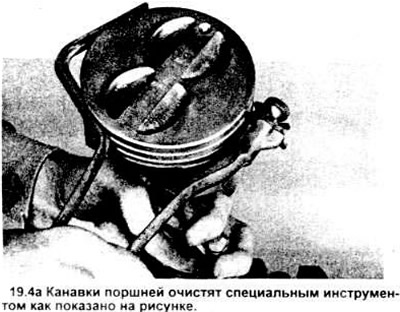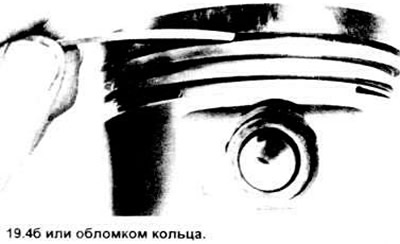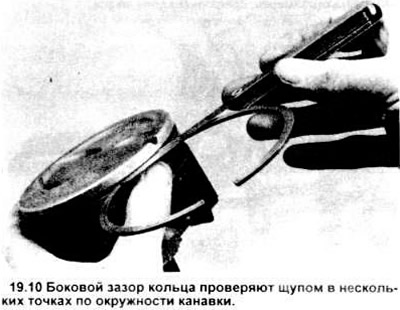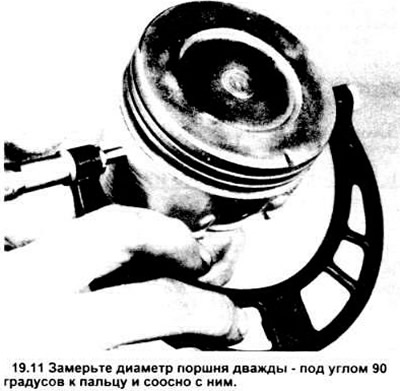Note: When overhauling an engine, always install new piston rings.
2. Use a ring setting tool to carefully remove the rings from the pistons. Do not hit or scratch the pistons.
3. Clean off any charcoal marks from the top of the piston. After you have scraped off most of the sediment, work with a hand wire brush or a piece of emery.
Caution: Under no circumstances should you use a wire brush installed in an electric drill to clean the pistons. The material of the pistons is soft and will suffer significantly from such a brush.
4. To clean the grooves of the pistons from coal deposits, use a tool specially designed for this. If not, you can use a piece of the old piston ring. At the same time, clean off only deposits of coal - do not scrape metal, do not scratch the walls of the piston grooves and do not knock on them (see picture).


5. After cleaning the deposits, clean the piston and connecting rod assemblies with solvent and dry with compressed air. Make sure the oil return holes in the rear walls of the piston grooves are clean.
6. If the cylinder walls and pistons are not damaged and not particularly worn, the engine block does not require boring, then new pistons will not be needed. Piston wear usually shows up as obvious on the vertical axial surfaces and slight slack in the top ring relative to its groove. But, when rebuilding the engine, it is necessary to install new piston rings.
7. Carefully inspect each piston for surface cracks, pin bosses and ring contact surfaces.
8. Look for scuffs and scratches on the axial surfaces of the cylinder, holes and burns in the piston head. If the piston skirt is worn or scratched, there may be overheating and abnormal operation of the engine on the compression stroke, which means too high operating temperatures. Check lubrication and cooling systems. A hole in the piston head indicates defects in the compression stroke (abnormal ignition). Burnt spots on the piston head are usually indicative of detonation on ignition. If these defects are identified, the causes must be eliminated immediately, otherwise damage will occur again.
9. Piston corrosion in the form of small spots indicates that coolant is leaking into the combustion chamber and/or crankcase. The cause must be eliminated, otherwise the defect will also appear in the enumerated engine
10. Measure backlashes between pistons and rings. To do this, put a new piston ring in each groove and insert a feeler gauge between it and the piston (see drawing). The gap must be checked in 3-4 places in each groove. Each groove has its own ring - they are different, do not confuse. If the gap is more than acceptable, new pistons will have to be installed.

11. Check the gap between the piston and the cylinder wall by measuring the diameters of the piston and cylinder, respectively (see picture). Find the difference between these two values; this will be the size of the gap. If it is more than the allowable value, then you will have to bore holes in the block and install new pistons and rings.

12. Determine the clearance between the piston and connecting rod. Any noticeable play is an indication of excessive wear that needs to be corrected.
13. Disconnecting the piston from the connecting rod requires special equipment.
14. Check up rods on cracks and other damages. Remove the connecting rod caps, remove the old bearing shells, wipe their working surfaces clean and examine for dents, scratches, nicks. After checking the connecting rods, reinstall the old bearings, fit the caps, and hand-tighten the nuts.
Visitor comments